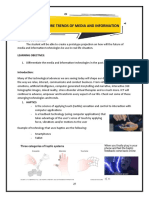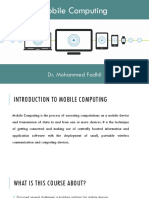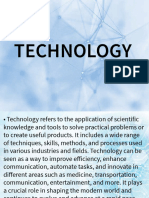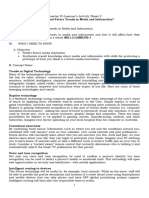0 ratings0% found this document useful (0 votes) 40 views7 pagesCyber Security Unit 2
Copyright
© © All Rights Reserved
We take content rights seriously. If you suspect this is your content,
claim it here.
Available Formats
Download as PDF or read online on Scribd
Unit-2
Cyber Crime
Mobile and wireless devices are like digital companions that don’t need
a physical connection to work. They include smartphones, tablets, and
other gadgets that communicate wirelessly, allowing users to stay
connected and access information on the go.
Features:
1. Portability: These devices are small and easy to carry, allowing
users to stay connected wherever they go.
2. Wireless Connectivity: They use technologies like Wi-Fi,
Bluetooth, and mobile networks to connect to the internet and
other devices.
3, Multifunctionality: Beyond calls and messages, they serve as
cameras, GPS devices, entertainment hubs, and more.
Common Examples:
1. Smartphones: Devices with touchscreens, internet access, and a
variety of apps.
2. Tablets: Larger than smartphones, often used for productivity and
entertainment.
3. Wearable Devices: Smartwatches and fitness trackers that connect
to smartphones.
Importance:
4%
1, Communication: Keeping people connected through calls,
messages, and social media.
2. Information Access: Providing instant access to the internet for
information, news, and entertainment.
3. Productivity: Enabling work and productivity on the go through
various apps and functionalities.
Edu Desire�Example: Think of your smartphone as a pocket-sized computer. It's not
just for making calls; it's your camera, map, music player, and more.
Mobile and wireless devices have become essential in our daily lives,
offering convenience and connectivity beyond what traditional devices
can provide.
Proliferation of Mobile and Wireless Devices:
Proliferation of mobile and wireless devices is like the widespread
growth or spread of smartphones, tablets, and other wirelessly
connected gadgets. It reflects the increasing number of these devices in
our daily lives.
Key Factors:
1. Technological Advancements: Continuous improvements in
technology make devices more affordable and accessible.
2, Increased Connectivity: The rise of high-speed internet and
wireless networks enables seamless communication.
3. Versatility: Mobile devices offer a variety of functions, from
communication to entertainment and productivity.
4, Consumer Demand: People increasingly rely on mobile and
wireless devices for convenience and on-the-go access.
Impact:
1. Global Connectivity: People worldwide can connect instantly,
transcending geographical boundaries.
2. Digital Transformation: The way we communicate, work, and
access information has undergone a significant shift.
3. Business and Innovation: The proliferation of devices has spurred
innovations in app development, services, and digital solutions.
Challenge:
1. Security Concerns: With more devices in use, there's an increased
risk of cybersecurity threats and privacy issues.
2. Digital Divide: Disparities in access to mobile technology can
create inequalities in information and opportunities.
15 Edu Desire�3. Dependency: Over Reliance on mobile devices may impact
face-to-face interactions and physical activities.
Trends in Mobility:
1. 5G Revolution: The 5G Revolution is like the superhero of internet
speed. It's the fifth generation of mobile networks, bringing faster speeds
and more reliable connections to mobile and wireless devices.
Impact:
* High-Speed Connectivity: Faster internet speeds for quicker
downloads and smoother streaming.
« IoT Advancements: Enables better connections for the Internet of
Things (IoT) devices.
2. Mobile App Ecosystem: The Mobile App Ecosystem is like a digital
marketplace. It encompasses the diverse range of applications available
for download on mobile devices.
Impact:
« Diverse Applications: Apps for communication, productivity,
entertainment, and more.
© App Integration: Seamless integration of apps for a smoother user
experience.
3. Mobile Security Measures: Mobile Security Measures are like digital
bodyguards for your devices. With the increasing use of mobile devices,
there's a growing focus on ensuring their security.
Impact:
* Biometric Authentication: Fingerprint and facial recognition for
enhanced device security.
* Mobile Device Management (MDM): Tools for businesses to secure
and manage mobile devices.
16 Edu Desire�4. Edge Computing: Edge Computing is like having a mini-brain in your
device. Instead of relying solely on a centralised server, computations
happen closer to the source of data.
Impact:
* Reduced Latency: Faster response times for applications and
services.
* Improved Privacy: Processing sensitive data locally without
sending it to a central server.
5. Augmented Reality (AR) and Virtual Reality (VR): Augmented Reality
(AR) and Virtual Reality (VR) are like digital realms overlaying or
immersing into the real world, enhancing user experiences.
Impact:
* Enhanced User Engagement: AR adds digital elements to the real
world, while VR creates immersive environments.
* Applications in Various Industries: From gaming to healthcare
and education.
6, Remote Work and Collaboration: Remote Work and Collaboration are
like the new-age workspaces. With the advancement of mobile
technology, working from anywhere and collaborating seamlessly has
become a trend.
Impact:
* Flexibility: Allows professionals to work from different locations.
* Virtual Meetings: Increased reliance on mobile devices for virtual
collaboration.
7. Sustainable Mobility: Sustainable Mobility is like a green approach to
technology. It involves the development and use of mobile solutions that
minimise environmental impact.
7 Edu Desire�Impact:
Green Technologies: Focus on eco-friendly materials. and
energy-efficient designs.
Reduced E-Waste: Efforts to extend the lifespan of devices and promote
recycling.
Credit Card Frauds in Mobile: Credit Card Frauds in Mobile are like
digital heists targeting your financial information on mobile devices. It
involves unauthorised access to credit card details, leading to financial
losses and potential identity theft.
Common Techniques:
1. Phishing: Fraudsters use fake messages or emails to trick users
into revealing credit card information.
2, Mobile Malware: Malicious software on mobile devices can
capture credit card details.
3. Fake Apps: Fraudulent mobile applications mimic legitimate ones
to steal credit card information.
4. Unsecured Wi-Fi: Conducting transactions on unsecured Wi-Fi
networks makes it easier for hackers to intercept data.
Preventive Measures:
1. Use Trusted Apps: Only download apps from official app stores to
avoid fake applications.
2. Secure Wi-Fi: Avoid sensitive transactions on public Wi-Fi
networks; use secure connections.
3. Two-Factor Authenticatio
for mobile transactions.
Enable additional layers of security
4. Regular Monitoring: Keep a close eye on credit card statements for
any unauthorised transactions.
Impact:
1. Financial Loss: Unauthorised transactions can lead to direct
monetary losses.
18 Edu Desire�2. Identity Theft: Stolen credit card information may be used for
identity theft.
3. Credit Score Impact: Fraudulent activities can negatively impact
credit scores.
Example: Imagine receiving a message that looks like it's from your
bank, asking for your credit card details to resolve an issue. If you
provide this information, you've fallen victim to Credit Card Frauds in
Mobile. It's crucial to stay vigilant, verify messages, and adopt secure
practices to protect your financial information on mobile devices.
Wireless Computing Era: The Wireless Computing Era is like a
technological revolution, marking a shift from traditional wired
connections to a world where computing devices communicate and
connect wirelessly.
Key Elements:
1. Wireless Networks: Use of technologies like Wi-Fi, Bluetooth, and
cellular networks for device connectivity.
2. Mobile Devices: Proliferation of smartphones, tablets, and
wearables, untethered from physical connections.
3. Cloud Computing: Storing and accessing data and applications
over the internet instead of on local devices.
Characteristics:
1. Mobility: Computing devices can be used and moved without the
constraints of physical cables.
2, Instant Connectivity: Devices can connect to the internet and
each other instantly, enhancing communication.
3. Ubiquitous Access: Information and applications are accessible
from almost anywhere, fostering a connected environment.
19 Edu Desire�Technological Enablers:
1. 5G Technology: High-speed, low-latency wireless networks
supporting advanced applications.
2. IoT Integration: Interconnected devices, from smart homes to
industrial sensors, communicating wirelessly.
3. Edge Computing: Processing data closer to the source, reducing
reliance on centralised servers.
Impact on Society:
1. Digital Transformation: Changing the way businesses operate,
communicate, and deliver services.
2. Remote Work Revolution: Allowing individuals to work from
anywhere, transforming traditional workspaces.
3. Smart Living: Integration of wireless technologies in homes,
making them smart and connected.
Challenges and Considerations:
1
Security Concerns: The need for robust cybersecurity measures to
protect wireless communications.
Digital Inclusion: Ensuring equal acc
to bridge the digital divide.
ss to wireless technologi
Privacy Issues: Balancing the convenience of wireless computing
with individual privacy considerations.
Example: Imagine a world where you can seamlessly connect to the
internet, work, and communicate without any physical constraints.
That's the essence of the Wireless Computing Era, where the airwaves
carry the pulse of our digital lives, shaping the way we live, work, and
connect.
20
Edu Desire




























































